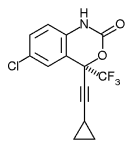A genetic mutation seven times as common in blacks as in whites increases the odds that people taking a common HIV medicine will surfer side effects that lead them to halt the treatment. Because the mutation slows metabolism of the drug efavirenz, patients of either race who have the genetic trait might be better off receiving, from the start of therapy, only a low dose of efavirenz, says David W. Haas of Vanderbilt University in Nashville.
Efavirenz is commonly a component of drug cocktails used to fight HIV, but it tan cause neurological problems such as disturbing dreams and dizziness. Haas and his colleagues, including Heather Ribaudo of the Harvard School of Public Heath in Boston, investigated several factors that might predict an individual's response to efavirenz.
The researchers gave a multidrug treatment that included efavirenz to 202 volunteers recently diagnosed with HIV. From individuals' responses to the drugs, the scientists calculated whether factors such as race, weight, and sex are associated with how quickly the body metabolizes efavirenz, how effectively the drug suppresses replication of HIV in blood, and how likely a person is to quit using the drug during the first 6 months of treatment.
Slow breakdown of a drug can be important for the effectiveness of treatment but can also increase the risk of side effects. Researchers already knew that heavy people tend to metabolize efavirenz relatively quickly.
In the new study, only weight and race showed any statistical link with how quickly the volunteers cleared efavirenz from their blood, Ribaudo reported Feb. 11 in San Francisco at the Conference on Retroviruses and Opportunistic Infections. People who cleared the drug slowly didn't benefit more from efavirenz treatment but were likelier to stop using the drug than other patients were, Ribaudo says.
The non-Hispanic white volunteers typically metabolized the drug 32 percent more rapidly than the volunteers of other ethnic groups did. To better understand that racial difference, the researchers analyzed four genes known to influence metabolism of other drugs. They found that one mutation, in a gene called CYP2B6, slows efavirenz clearance and thereby nearly triples the average blood concentration of the drug, Haas says. The genetic trait, which occurs in 20 percent of blacks but only 3 percent of whites, also increases the risk of serious neurological side effects. One other mutation, found almost exclusively in blacks, was also associated with slower drug clearance.
The two genes account for the racial differences observed in efavirenz metabolism, Haas says.
Prescription guidelines tailored to genetics rather than race could personalize medicine, sacs Robert T. Schooley of the University of Colorado Health Sciences Center in Denver. Currently, federally funded studies of efavirenz and other HIV drugs must evaluate outcomes by racial and ethnic groups.
Those trials could become unnecessary, Schooley says, if doctors eventually could use specific genes, instead of a biologically ambiguous category such as race, to anticipate a patient's response to a drug.
COPYRIGHT 2004 Science Service, Inc.
COPYRIGHT 2004 Gale Group



